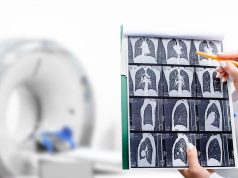Documentation found to be rarely provided for high-risk indeterminate pulmonary nodes
THURSDAY, Dec. 21, 2017 (HealthDay News) — For patients with high-risk indeterminate pulmonary nodes (IPNs), physicians rarely provide quantitative documentation of cancer probability, according to a study published online Dec. 20 in JAMA Surgery.
Amelia W. Maiga, M.D., M.P.H., from Tennessee Valley Healthcare System in Nashville, and colleagues conducted a single-center retrospective cohort study to determine whether clinicians document the probability of malignancy in high-risk IPNs. Chart review data were included for 291 veterans undergoing surgical resection of known or suspected lung cancer (cohort 1) and for 239 veterans undergoing inpatient or outpatient pulmonary evaluation of IPNs (cohort 2).
The researchers found that cancer prevalence was 88.7 and 48.9 percent in cohorts 1 and 2, respectively. In cohorts 1 and 2, only 4.5 and 1.3 percent of patients had a documented quantitative prediction of malignancy before tissue diagnosis. Of the remaining patients, 78.1 and 63.1 percent had qualitative statements of cancer risk. A final diagnosis of cancer was reported for 29.1 percent of patients in cohort 2 without any documented malignancy risk statements. There were 32 broad categories of qualitative risk statements. Compared with cohort 2, for cohort 1 the most frequently used qualitative risk statements aligned well with Mayo Clinic Model predictions. The probability of cancer predicted by the median Mayo Clinic Model was 68.7 percent. There was rough alignment for qualitative risk statements with Mayo predictions.
“A standard scale that correlates with predicted cancer risk for IPNs should be used to communicate with patients and other clinicians,” the authors write.
Copyright © 2017 HealthDay. All rights reserved.








